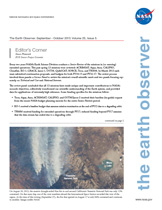



Recent Imagery
You will be directed to the NASA Visible Earth webpage when you select Images by Mission below, or click on the images at right that are randomly generated to represent four out of all possible topics.
The Earth Observer has a new look! Visit the NEW Earth Observer website.
The Earth Observer: Sep - Oct 2013
In This Issue
Click title below to view page
- Editor’s Corner Front Cover
- Feature Articles
- The SAGE Legacy’s Next Chapter: SAGE III on the International Space Station4
- NASA Reaches Conservation Biology Community9
- NASA Satellite Data Used to Study the Impact of Oil Palm Expansion Across Indonesian Borneo12
- Meeting/Workshop Summaries
- Land, Atmosphere Near-Real-Time Capability for EOS (LANCE) User Working Group Meeting Summary17
- ESIP Federation Meeting Highlights Data Practices21
- Summary of the 43rd Advanced Spaceborne Thermal Emission and Reflection Radiometer (ASTER) Science Team Meeting24
- Announcements
- Data Release: Version 007 HIRDLS Atmospheric Products8
- Data Release: Version 4 SeaWiFS Deep Blue23
- Come Explore NASA Science at the 2013 Fall AGU Meeting28
- In The News
- Around the World in Four Days: NASA Tracks Chelyabinsk Meteor Plume27
- After a Fire, Before a Flood: NASA’s Landsat Directs Restoration to At-Risk Areas29
- Search On for Climate Clues Across Southern U.S. Skies31
- Regular Features
- NASA Earth Science in the News 32
- NASA Science Mission Directorate – Science Education and Public Outreach Update 34
- Science Calendars 35
Editor’s Corner
Steve Platnick
EOS Senior Project Scientist
Every two years NASA’s Earth Science Division conducts a Senior Review of the missions in (or entering) extended operations. This past spring 13 missions were reviewed: ACRIMSAT, Aqua, Aura, CALIPSO, CloudSat, EO-1, GRACE, Jason-1, OSTM, QuikSCAT, SORCE, Terra, and TRMM. In March 2013 each team submitted continuation proposals, and budgets for both FY14-15 and FY16-17. The review process involved three panels: a Science Panel to review the mission’s overall scientific merit and two panels focusing separately on Technical and Cost and National Interests.
Read more...

